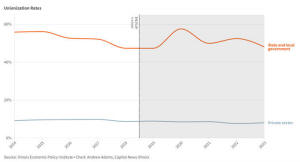Report shows Illinois union participation declining despite growth in
new petitions
 Send a link to a friend
Send a link to a friend
[August 31, 2024]
By JERRY NOWICKI
Capitol News Illinois
jnowicki@capitolnewsillinois.com
 SPRINGFIELD – Overall participation in labor unions has declined in
recent years in Illinois, although the state has seen an increase in
successful unionization efforts for the second year in a row. SPRINGFIELD – Overall participation in labor unions has declined in
recent years in Illinois, although the state has seen an increase in
successful unionization efforts for the second year in a row.
That’s according to the State of the Unions 2024 report, the latest
installment in an annual review of unionization in Illinois and the U.S.
by the Illinois Economic Policy Institute and the University of
Illinois’ Project for Middle Class Renewal. ILEPI is a nonprofit
research organization with a board of directors that’s closely tied to
organized labor.
The study found that Illinois saw 86 successful union petitions in 2023,
up from 67 the year before. Those are the two highest totals in a
10-year period dating back to 2014. The prior eight years ranged from 25
to 62 successful petitions.
“When you see a couple of positive years where you're seeing growth in
in numbers, it does suggest that there's some change in the labor
market, there's some change in worker attitudes, there's some change in
the strategy of union organizers,” Robert Bruno, a report co-author and
director of the Project for Middle Class Renewal said in an interview.
“It all suggests a positive turn.”
The successful petitions led to 4,399 additional workers being unionized
in 2023, down from 9,497 in 2022.

“That's from coffee shops to hospitals to cannabis producers to
top-ranked universities,” said Frank Manzo, a report co-author and
economist with ILEPI, said. “You know, private and nonprofit workers
successfully organized dozens of workplaces, showing that the labor
movement is gaining traction in new and emerging industries.”
Despite the increase in private sector unionization efforts, the
percentage of Illinois’ workforce that is unionized dropped below 13
percent for the first time in the 10-year period surveyed. At 12.8
percent, Illinois had the 13th-highest unionization rate among all
states. A total of 707,829 people in Illinois were unionized in 2023,
down from nearly 847,000 in 2015.
The public sector unionization rate has declined by a total of 4.1
percentage points since the U.S. Supreme Court handed down a decision in
Janus vs. AFSCME, from 52.1 percent to 48 percent. That ruling put an
end to public sector unions being able to charge fees to individuals who
benefit from union representation but choose not to join the union.
Those fees, often referred to as “fair share” fees, helped unions better
negotiate wage and benefit structures for all employees, regardless of
whether they are part of the union. Without them, Manzo said, unions are
required to represent those individuals without compensation.
“It is true that the most significant contributor to the declines in
Illinois' unionization rate has been drops in worker bargaining power in
the public sector that was sparked by a 2018 Supreme Court decision,”
Manzo said.

[to top of second column]
|

While private sector unionization rates have fallen by 1.7
percentage points since the U.S. Supreme Court handed down the Janus
decision in 2018, public sector unionization rates fell by 4.1
points in that span. Public sector unionization remains near 50
percent. (Capitol News Illinois graphic by Andrew Adams)

Another contributor to union participation decline is that the economy
has added jobs in sectors with “low union densities,” like management,
professional services, e-commerce and the gig economy, he said. At the
same time, careers with long-standing union ties, such as mining and
manufacturing, have either grown more slowly or “been lost altogether,”
he said.
But he added that other states, including many surrounding Illinois,
have enacted “right-to-work” laws, which create “Janus-like conditions”
in the private sector.
Illinois’ Workers’ Rights Amendment – an amendment to the state
constitution that was approved by voters in 2022 – “effectively bans
those so-called right-to-work laws from ever coming to the state,” Manzo
said.
“And the data show that states that protect workers rights, like
Illinois, have higher wages, faster wage growth and stronger unions
compared to those that have weakened collective bargaining rights,” he
said.
While Illinois’ unionization rate was 12.8 percent in 2023, nearby
states that have right-to-work laws – Iowa, Indiana, Kentucky and
Wisconsin – had rates ranging from 7.1 percent to 8.8 percent.
Average hourly earnings in Illinois were $36.82 in 2023, compared to
rates of $28.82 to $31.84 in the four neighboring right-to-work states,
although Illinois’ cost of living is generally higher than in those
states, which don’t have a city comparable to Chicago’s size.
Illinois’ wage growth from 2017 to 2023 was an average of 4.6 percent
higher than those four states, based on the study’s review of the U.S.
Department of Labor’s Current Population Survey data. Unionized Illinois
workers earn about 12.6 percent more than non-union workers, per the
same analysis.

The study found Black workers, men, military veterans, and workers with
master’s degrees have the highest unionization rates in Illinois.
Nationally, the U.S. added 135,000 new union members in 2023, following
a gain of 277,000 union members in 2022, according to the report. Unions
are also seeing near record-high support, with 67 percent of respondents
viewing them favorably, per a Gallup poll cited in the report.
“Despite dealing with an economy in transition and facing considerable
legal challenges, unions are organizing new industries and improving job
quality,” Manzo said.
Capitol News Illinois is
a nonprofit, nonpartisan news service covering state government. It is
distributed to hundreds of newspapers, radio and TV stations statewide.
It is funded primarily by the Illinois Press Foundation and the Robert
R. McCormick Foundation, along with major contributions from the
Illinois Broadcasters Foundation and Southern Illinois Editorial
Association. |